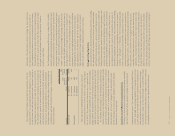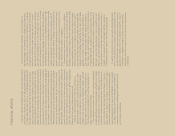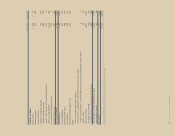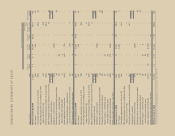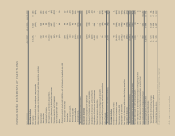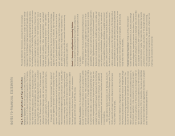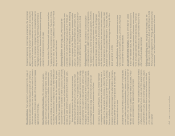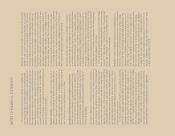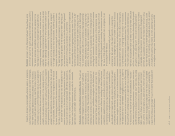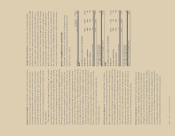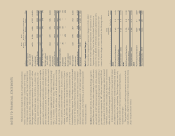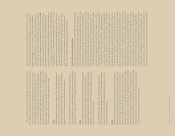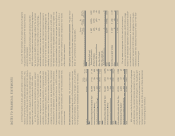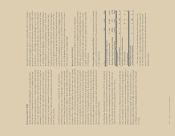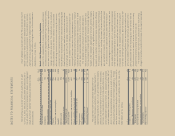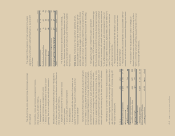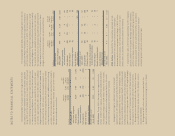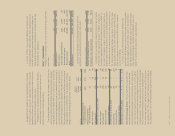Sara Lee 2011 Annual Report Download - page 89
Download and view the complete annual report
Please find page 89 of the 2011 Sara Lee annual report below. You can navigate through the pages in the report by either clicking on the pages listed below, or by using the keyword search tool below to find specific information within the annual report.
Goodwill Goodwill is the difference between the purchase price
and the fair value of the assets acquired and liabilities assumed in
a business combination. When a business combination is completed,
the assets acquired and liabilities assumed are assigned to the
reporting unit or units of the corporation given responsibility for
managing, controlling and generating returns on these assets and
liabilities. Reporting units are business components at or one level
below the operating segment level for which discrete financial infor-
mation is available and reviewed by segment management. In many
instances, all of the acquired assets and liabilities are assigned
to a single reporting unit and in these cases all of the goodwill is
assigned to the same reporting unit. In those situations in which
the acquired assets and liabilities are allocated to more than one
reporting unit, the goodwill to be assigned to each reporting unit
is determined in a manner similar to how the amount of goodwill
recognized in the business combination is determined.
Goodwill is not amortized; however, it is assessed for impairment
at least annually and as triggering events may occur. The corpora-
tion previously performed its annual review for impairment in the
second quarter of each fiscal year but moved its testing to the
fourth quarter beginning in fiscal year 2010 in order to better align
the impairment review with the corporation’s long-range planning
process. Recoverability of goodwill is evaluated using a two-step
process. The first step involves a comparison of the fair value of
a reporting unit with its carrying value. If the carrying value of the
reporting unit exceeds its fair value, the second step of the process
is necessary and involves a comparison of the implied fair value
and the carrying value of the goodwill of that reporting unit. If the
carrying value of the goodwill of a reporting unit exceeds the implied
fair value of that goodwill, an impairment loss is recognized in an
amount equal to the excess.
In evaluating the recoverability of goodwill, it is necessary to
estimate the fair values of the reporting units. In making this
assessment, management relies on a number of factors to discount
anticipated future cash flows, including operating results, business
plans and present value techniques. The fair value of reporting units
is estimated based on a weighting of two models – a discounted
cash flow model and a market multiple model. The discounted cash
flow model uses management’s business plans and projections as
the basis for expected future cash flows for the first three years and
a 2% to 4% residual growth rate thereafter depending on the growth
prospects for the reporting unit. The market multiple approach
employs market multiples of revenues and earnings for companies
comparable to the corporation’s reporting units. Management
believes the assumptions used for the impairment test are consis-
tent with those utilized by a market participant performing similar
valuations for our reporting units. A separate discount rate derived
from published sources was utilized for each reporting unit and,
on a weighted average basis, the discount rate used was 9.8%.
Property is tested for recoverability whenever events or changes in
circumstances indicate that its carrying value may not be recoverable.
Such events include significant adverse changes in the business
climate, current period operating or cash flow losses, forecasted
continuing losses or a current expectation that an asset group will
be disposed of before the end of its useful life. Recoverability of
property is evaluated by a comparison of the carrying amount of an
asset or asset group to future net undiscounted cash flows expected
to be generated by the asset or asset group. If the carrying amount
exceeds the estimated future undiscounted cash flows then an asset
is not recoverable. The impairment loss recognized is the amount
by which the carrying amount of the asset exceeds the estimated
fair value using discounted estimated future cash flows.
Assets that are to be disposed of by sale are recognized in the
financial statements at the lower of carrying amount or fair value,
less cost to sell, and are not depreciated after being classified as
held for sale. In order for an asset to be classified as held for sale,
the asset must be actively marketed, be available for immediate
sale and meet certain other specified criteria.
Trademarks and Other Identifiable Intangible Assets The primary
identifiable intangible assets of the corporation are trademarks
and customer relationships acquired in business combinations
and computer software. The corporation capitalizes direct costs of
materials and services used in the development and purchase of
internal-use software. Identifiable intangibles with finite lives are
amortized and those with indefinite lives are not amortized. The
estimated useful life of a finite-lived identifiable intangible asset is
based upon a number of factors, including the effects of demand,
competition, expected changes in distribution channels and the level
of maintenance expenditures required to obtain future cash flows.
Identifiable intangible assets that are subject to amortization
are evaluated for impairment using a process similar to that used
in evaluating the recoverability of property, plant and equipment.
Identifiable intangible assets not subject to amortization are assessed
for impairment at least annually and as triggering events may occur.
The impairment test for identifiable intangible assets not subject to
amortization consists of a comparison of the fair value of the intangi-
ble asset with its carrying amount. An impairment loss is recognized
for the amount by which the carrying value exceeds the fair value
of the asset. In making this assessment, management relies on a
number of factors to discount estimated future cash flows including
operating results, business plans and present value techniques.
Rates used to discount cash flows are dependent upon interest
rates and the cost of capital at a point in time. There are inherent
assumptions and judgments required in the analysis of intangible
asset impairment. It is possible that assumptions underlying the
impairment analysis will change in such a manner that impairment
in value may occur in the future.
86/87 Sara Lee Corporation and Subsidiaries


